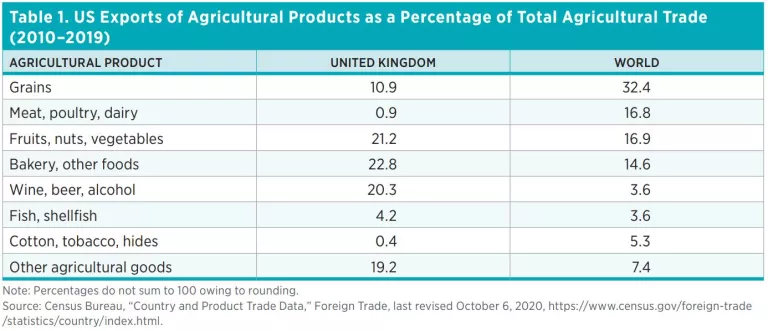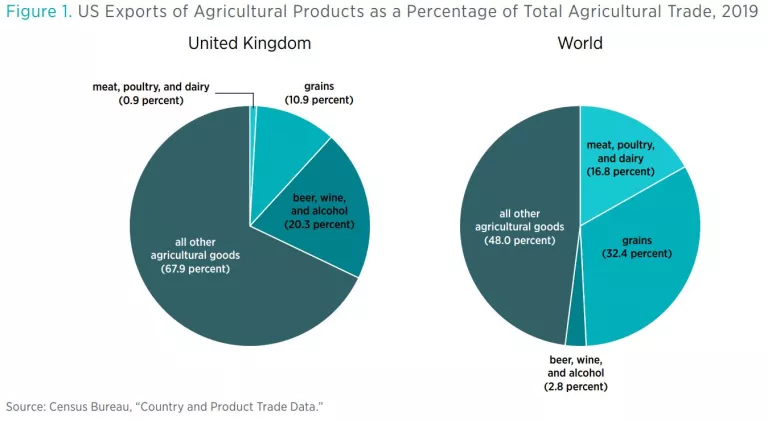- | International Freedom and Trade International Freedom and Trade
- | Policy Briefs Policy Briefs
- |
Removing Barriers to US-UK Agricultural Trade
Agriculture is far from the largest sector of trade between the United States and the United Kingdom, but it remains one of the more contentious issues in negotiating a US-UK free trade agreement. Nevertheless, agriculture offers the two nations an opportunity to liberalize trade for the benefit of consumers and producers on both sides of the Atlantic.
Negotiations toward a US-UK free trade agreement were formally launched in May 2020 and are expected to continue into 2021. With its scheduled January 2021 departure from the European Union Customs Union looming, the United Kingdom is entering a pivotal moment in its journey to establish independent trading relationships with the rest of the world. Finalizing a free trade agreement with the United States resolving agricultural issues would represent a significant step toward that goal.
The United States and the United Kingdom already engage in a substantial amount of two-way trade in agricultural products. In 2019, US producers exported $1.93 billion worth of agricultural products to the United Kingdom. Among the top categories of exports were wine, beer, and related products ($268 million), nuts ($236 million), alcoholic beverages excluding wine and beer ($124 million), and vegetables ($117 million). That same year, Americans imported $2.89 billion worth of agricultural products from the United Kingdom, with alcoholic beverages excluding wine and beer (mostly Scotch Whiskey) accounting for $2.07 billion. Other major categories of imports included fish and shellfish ($169 million) and bakery products ($132 million). See table 1 for a breakdown of two-way trade in agricultural products.


Agricultural Tariffs Remain Stubbornly High
The primary reason agricultural trade between the United States and the United Kingdom has been low compared with other sectors and other nations is rooted in remaining trade barriers, both tariff and nontariff barriers. Despite a general decrease in manufacturing tariffs in recent decades, tariffs on agricultural products remain stubbornly high on both sides of the Atlantic. According to the World Trade Organization, the United States applies an average weighted tariff rate of 4.6 percent against agricultural imports, and the European Union applies a 9.2 percent tariff on its agricultural imports. The highest US tariffs fall on dairy products (19 percent) and sugar and confectionary products (14.9 percent), and the highest EU tariffs apply to dairy products (37 percent), sugar and confectionery products (24.5 percent), and animal products (16 percent).
After departing the European Union Customs Union on January 1, 2021, the United Kingdom will impose its own schedule of duties called the UK Global Tariff. The UK Global Tariff reduces or eliminates tariffs on a range of items, increasing the proportion of product categories that may enter the United Kingdom duty-free from 27 percent under the European Union’s common tariff to 47 percent. The UK government has decided to retain 5,000 tariff lines, including most agricultural tariffs. On dairy products, for example, the UK Global Tariff will replace the European Union’s protectionist Meursing code with a simplified but still significant list of tariffs. As the UK Secretary of State for International Trade Elizabeth Truss explained in a May 2020 paper introducing the UK Global Tariff, the farm tariffs “have been largely retained with the aim of maintaining similar current consumption and production patterns and avoiding additional disruption for UK farmers and consumers.”
To fully exploit the unique opportunity to liberalize trade between the two nations, a US-UK free trade agreement should commit both nations to the full elimination of all tariffs, including tariffs on agricultural products. It should not be the purpose of the tariff code in either nation to preserve current consumption and production patterns; instead, trade should be liberalized so that consumers in both nations can enjoy lower prices, more variety, and better quality in foods and beverages.
Reform Food Regulations to Protect Health, Not Domestic Producers
Along with tariffs, nontariff regulatory restrictions also suppress two-way trade in farm goods, although the stated purpose of such restrictions often has nothing to do with agricultural issues. As a member of the European Union, the United Kingdom imposed a number of regulations in the name of public health and safety that have historically prevented American agricultural products from entering the UK market.
The European Commission has long supported the restriction of US agricultural goods on the basis of the precautionary principle. Enshrined in Article 191(2) of the Treaty on the Functioning of the European Union, the precautionary principle is a core component of EU environmental law and raises barriers to external goods that the European Union deems to have “uncertain risks” for the environment. Agricultural goods that have been restricted from UK markets on the basis of the precautionary principle include the controversial chlorine-washed poultry, genetically modified crops, and hormone-induced beef. US trade negotiators have rightly complained that such a regulatory approach ignores globally accepted trade rules as well as the preponderance of scientific evidence that such practices pose no threat to public health.
The issue is not about whether the United States has lower food safety standards than the United Kingdom, but whether it has different standards that are just as effective in protecting public health and food safety. According to the Global Food Security Index, the United States has the fourth-highest food quality and safety standards in the world, significantly higher than many EU member states. In fact, it isn’t just the US Department of Agriculture and the FDA that approve the process of pathogen reduction treatment (PRT)—even the European Food Safety Authority acknowledged in a study from 2005 that “treatment with trisodium phosphate, acidified sodium chlorite, chlorine dioxide, or peroxyacid solutions, under the described conditions of use, would be of no safety concern.” In practice, washing chicken carcasses in chlorine and other PRT chemicals has proven to be more effective than alternatives in reducing the danger of salmonella poisoning in humans. What’s more, recent evidence suggests that animal welfare in production and processing standards are roughly the same in both countries when considering average and permitted densities.
In recent months, negotiators for both the United States and the United Kingdom have signaled their desire to lower agricultural trade barriers. These developments haven’t been limited to words; each side has also demonstrated political commitment to trade liberalization. After more than 20 years of banning British beef from US markets, the first shipments of beef departed the United Kingdom for the United States on September 30, 2020, marking a historic moment for UK farmers and food producers. Prime Minister Boris Johnson, long a vocal critic of anti-genetic-modification rules, stated in his first speech as prime minister, “Let’s start now to liberate the UK’s extraordinary bioscience sector from anti-genetic modification rules and let’s develop the blight-resistant crops that will feed the world.” US negotiators should work with their UK counterparts to ensure market access for US-grown genetically modified products.
Regulatory Equivalence: A mutually Beneficial Path Forward
In the ongoing negotiations, the US and UK trade negotiators should build upon such common ground to embrace an internationally accepted approach to risk assessment, particularly regarding sanitary and phytosanitary measures, as laid out by the Office of the US Trade Representative in its 2019 negotiating objectives. In attempting to address the issue, the British government has reportedly considered imposing a “dual” or “conditional” tariff system, whereby imports would only qualify for lower tariffs if they meet certain standards. However, the imposition of a dual tariff system would be rightly viewed as a protectionist trade measure. Instead, both sides should adopt a cooperative approach to establishing regulatory equivalence through consultation and multinational agreements.
There is already broad equivalence in high standards of safety, quality, and animal welfare conditions, and the two negotiating countries should look to advance approaches for establishing equivalence of existing regulations in both jurisdictions. The key objectives of trade negotiations should be removing tariff and nontariff barriers and increasing market access for the mutual benefit of all involved.
Similar tariff and regulatory issues that are on the table in the US-UK negotiations have been successfully addressed in existing free trade agreements between the United States and such trading partners as Australia, Canada, and South Korea. Each of those agreements eliminated most if not all agricultural tariffs while committing each party to address only genuine health and safety concerns through its regulations.
In the US-South Korea agreement, for example, tariffs fell to zero either immediately or after a phase-in period for corn, pork, nuts, beef, and poultry. As a result of the tariff reductions and fine tuning of regulations, US producers exported $2.50 billion in meat and poultry to South Korea in 2019, compared to a paltry $7.64 million to the United Kingdom, and $302 million in dairy products and eggs, compared to $10.3 million to the United Kingdom. In total, South Korea imported more than four times the value of US farm products ($8.13 billion) in 2019 than the United Kingdom ($1.93 billion), even though South Korea’s population, economy, and total trade with the United States are smaller than the United Kingdom’s.
An ambitious and comprehensive free trade agreement between the United States and the United Kingdom would unleash trade in agricultural products. The net welfare gain for both countries would be positive and significant; the major beneficiaries of a free trade agreement between the two nations would likely be UK consumers, through lower prices, and US producers, through increased agricultural exports.

